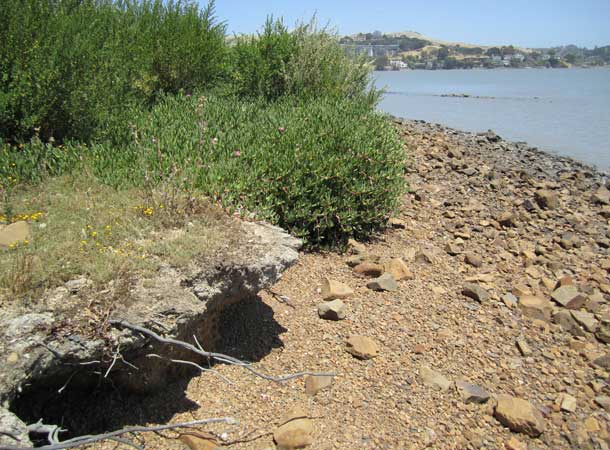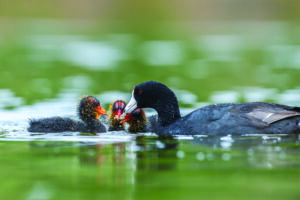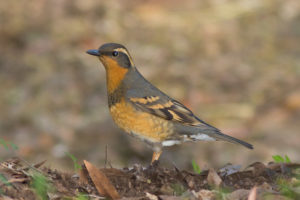Can a pile of dredge spoils covered in a jumble of invasive weeds be transformed into an island paradise for shorebirds, songbirds, and seals? The folks at the Richardson Bay Audubon Center and Sanctuary think so. And after years of planning, ground-breaking on their ambitious restoration project has finally begun.
Aramburu is a 17-acre island just east of Richardson Bay’s Strawberry Peninsula. Shaped like a long, skinny spoon, it’s the largest of three islands that rub watery shoulders with the Audubon Sanctuary in Tiburon. This modest archipelago originated as a dumping ground for dredged and excavated material, but birds and other wildlife colonized the islands almost immediately. For many years, it was an important harbor seal haul-out site, and in 1997 Marin County officially declared Aramburu a wildlife sanctuary.
But Aramburu isn’t fulfilling its potential. It’s smothered in non-native plants. Much of the eastern slope is steep and rocky, not ideal for shorebirds that prefer foraging on expansive mudflats. It’s also getting smaller, as erosion gnaws away at the eastern shore.
The restoration project addresses these shortcomings. The first phase–smoothing out the island’s edges–has already begun.
In the last two weeks earth-movers have scraped off non-native vegetation and re-graded the steep erosive scarp on the eastern shore. Next, barges delivered the new beach material: a combination of pea gravel, sands and crushed oyster shells.
“The difference is already pretty dramatic,” says Audubon Sanctuary Manager Kerry Wilcox.
- Invasive plants like these are being removed from the island, and the eroded bank seen in lower left will be smoothed out into a more gradual slope, preferred by shorebirds. Photo courtesy Richardson Bay Audubon Center, tiburonaudubon.org.
The Audubon Center worked with restoration ecologists Peter Baye and Roger Leventhal on a beach restoration plan using material with differently-sized grains that will interlock with each other, creating a stable “fabric.” In addition, large eucalyptus logs placed along the beach will help hold the material in place. This large woody debris will also create a “wave shadow” that reduces wave energy.
“We’re taking a soft engineering design approach” says Audubon ecologist Kathi Borgmann. After the initial sculpting and earth-moving, nature will be left to take its course.
***
A few days before the bulldozers rolled in, I paddled out to Aramburu with Borgmann and another volunteer to search for any active bird nests. It was a little late for nesting, but she wanted to make sure the earth-moving equipment wouldn’t disrupt any birds using the island to breed.
I felt privileged to step foot on Aramburu. Though only a pebble’s toss from the tony Tiburon neighborhood across the channel, access to the islands is highly restricted.
My first step was a slippery one, as we scaled rip-rap crusted with barnacles, dragging the kayak and canoe behind us. But unless we wanted to be up to our thighs in Bay mud, this was the best place to haul out.
“Let’s meet back here in two hours,” said Borgmann, once we were safely ashore. Without ceremony we struck out in three different directions.
I headed for the north end of the island, winding through thickets of thistle and clumps of broom, stopping occasionally. Nest searching is simple, but not an activity for the over-caffeinated: stop, look, listen; then look and listen some more.
A rustling in the broom caught my eye: a song sparrow with a fat green grub in its beak.
I crouched under an oak tree and watched, and before long spotted a fledgling, beak open and wings fluttering. With its crisply streaked breast and pristine feathers, the young sparrow looked freshly painted. Though it was still begging for food, the bird could fly, so after a few more minutes I moved on.
Although we were primarily looking for songbird nests, the biggest beneficiaries of the restoration will be the shorebirds that already frequent this and the neighboring islands, particularly the northernmost one, dubbed Pickleweed.
Pickleweed is several times smaller than Aramburu, but it consistently attracts more birds. The juxtaposition of the two islands has helped inform the restoration strategy.
“Having Pickleweed as a control site is really important and really unique,” says Borgmann.
Wilcox initiated shorebird surveys on all three islands in September 2009. He and a group of volunteers conducted surveys several times a month at both high and low tides.
“It became clear pretty quickly that Aramburu was the least utilized by the suite of shorebirds that visit the islands,” says Wilcox.
Two years of data have allowed him to start quantifying the striking differences among the islands. Not only are shorebird densities up to eight times higher on Pickleweed, overall numbers are higher as well.

- Mount Tamalpais looms over the rocky shoreline of Aramburu Island. Photo courtesy Richardson Bay Audubon Center, tiburonaudubon.org.
Pickleweed has several things going for it. “The island has a low profile, so it’s more or less inundated at high tide,” says Wilcox. The saltwater discourages nonnative plants, most of which can’t tolerate high salinity. In contrast to the collage of weeds on Aramburu, the dominant plant on Pickleweed is the island’s namesake salt-loving marsh plant; native cordgrass grows in the channels winding through the eastern shore. In addition, the island’s beaches slope gently; at low tide the exposed mudflats reach far beyond the island toward the channel. Birds flock to them.
“We see a lot of birds foraging at low tide, and a lot of birds resting at high tide,” Wilcox says.
I’ve witnessed this myself when helping out with shorebird surveys. The birds sort themselves out along the beach: marbled godwits stand in shallows, long beaks plunged into the mud, black-bellied plovers and sandpipers scurry along the shore, and clumps of gulls rest further back, heads tucked under wings. Other winter regulars include willets, long-billed curlews, dunlins, dowitchers, sandpipers, greater yellowlegs, and black turnstones. At high tide many of those same birds take refuge in the vegetation.
The combination of birds is never the same, and there’s always a chance to see something unusual. One week a couple hundred elegant terns might show up, only to disappear a few days later. The birds vary from year to year, from season to season, from day to day, and from tide to tide.
Back on Aramburu, I was hoping to find a surprise of a different kind. A pair of black-necked stilts had been caught acting suspiciously like anxious parents, yet so far no chicks had been seen.
I found the stilt pair–or rather, they found me–near a small pond at the north end of the island. One of them swooped past me–a handsome black and white bird dragging peppermint-stick legs–and immediately began scolding me with sharp cries. I turned and retreated toward the eastern shore, then snuck back through the oak grove towards the pond. Squatting behind clumps of weedy Harding grass, I spied on the pair. Both had returned to the pond. I kept watching. Something was moving in the pickleweed between the two adults. It had to be a chick! And it was. I finally glimpsed the distinctive black and white markings among the vegetation. The young stilt was half the size of its parents, and remarkably well-concealed.
The area near the pond is one of the few extensive pickleweed patches on Aramburu. Much of the island is overrun with nonnatives: thistle, Harding grass, French broom, acacia, and iceplant, among others. The restoration will create native tidal marsh near the shore and grassland habitat in the uplands. In addition, some of the low spots in the upland portion of the island will serve as vernal pools, which are often refugia for rare native plants.
The new landscape won’t happen overnight.
“This phase will take several years,” says Borgmann. After re-grading, the island will be capped with a thin layer of Bay mud and seeded with saltgrass, which will act as a natural barrier to discourage weeds from re-colonizing. Restoration workers may also put in saltwater irrigation, which has been used successfully in the South Bay to control invasive plants. Audubon staff will get native plants from Richmond’s Watershed Nursery, though they have also started a plant nursery on their property in Tiburon.
The re-vegetation phase won’t even begin for at least a year, and additional sources of funding must be found. Already the project is costing more than was anticipated.
***
It was easy to set aside worries, financial and otherwise, while watching the stilt chick thread through the pickleweed, flanked by its vigilant parents. But two hours of stopping, looking, and listening had passed. I hurried back to join the others and compare notes. We’d each seen several song sparrows and goldfinch fledglings, but none of us had found an active nest. It was time to paddle back.
Though it was exciting to learn that stilts are breeding on Aramburu, the pair is something of an anomaly, since stilts usually breed in colonies. Wilcox points out that the goal of the project isn’t to create breeding habitat. He says there probably isn’t enough area on the islands to support breeding colonies or individuals like rails. The greatest value of the islands is for foraging and resting.
Because birds are so opportunistic, they may take advantage of Aramburu’s newly enhanced shoreline sooner than later.
“Shorebirds are so mobile,” says Borgmann. “The new habitat could be colonized right away.” The next phase of the project, which may or may not happen this year, will be to import fine-grained sand to supplement the sandy foreshore a little further out from the beach. Sediment sampling has revealed a good variety of invertebrates in the foreshore area, so a plentiful buffet should welcome any newcomers.
Wilcox plans to continue the shorebird surveys in October, once the first phase of construction is complete. He’s not making any predictions, but he’s optimistic.
“It’s exciting to think about the possibilities.”
To follow the progress of the Aramburu restoration, see tiburonaudubon.org or visit them on Facebook.

.jpg)




